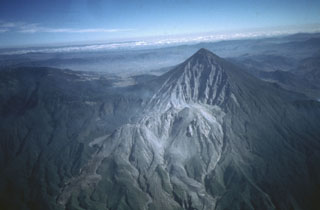Report on Santa Maria (Guatemala) — August 1987
Scientific Event Alert Network Bulletin, vol. 12, no. 8 (August 1987)
Managing Editor: Lindsay McClelland.
Santa Maria (Guatemala) Lava flow from dome; many avalanches; explosions
Please cite this report as:
Global Volcanism Program, 1987. Report on Santa Maria (Guatemala) (McClelland, L., ed.). Scientific Event Alert Network Bulletin, 12:8. Smithsonian Institution. https://doi.org/10.5479/si.GVP.SEAN198708-342030
Santa Maria
Guatemala
14.757°N, 91.552°W; summit elev. 3745 m
All times are local (unless otherwise noted)
An incandescent block lava flow continued to emerge from Cono Caliente (the active crater on the E side of the dome), advancing down the S flank. By the end of July its front was between 1,200 and 1,300 m elevation in a canyon 80 m wide and 30 m deep, about 1.5 km from the Nimá II river. Numerous avalanches occurred from the flow front and along its channel. There were some reports of explosions from the flow front; fumaroles and a gaseous odor were noted there by geologists. Sporadic explosions from Cono Caliente ejected light-colored ash, and gas emission was continuous.
Geological Summary. Symmetrical, forest-covered Santa María volcano is part of a chain of large stratovolcanoes that rise above the Pacific coastal plain of Guatemala. The sharp-topped, conical profile is cut on the SW flank by a 1.5-km-wide crater. The oval-shaped crater extends from just below the summit to the lower flank, and was formed during a catastrophic eruption in 1902. The renowned Plinian eruption of 1902 that devastated much of SW Guatemala followed a long repose period after construction of the large basaltic andesite stratovolcano. The massive dacitic Santiaguito lava-dome complex has been growing at the base of the 1902 crater since 1922. Compound dome growth at Santiaguito has occurred episodically from four vents, with activity progressing E towards the most recent, Caliente. Dome growth has been accompanied by almost continuous minor explosions, with periodic lava extrusion, larger explosions, pyroclastic flows, and lahars.
Information Contacts: E. Sánchez, INSIVUMEH.

